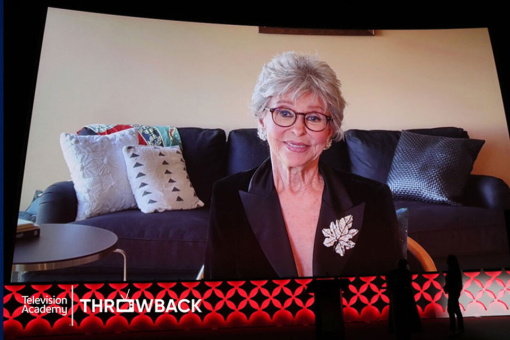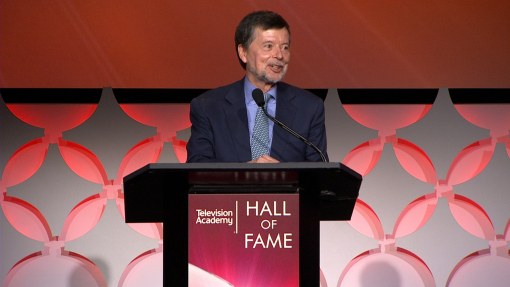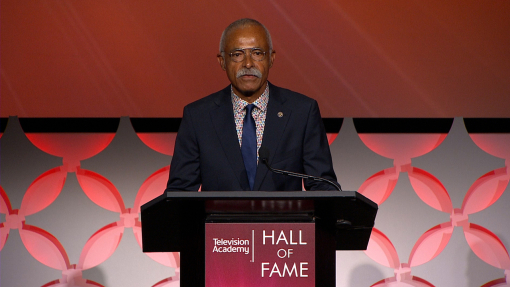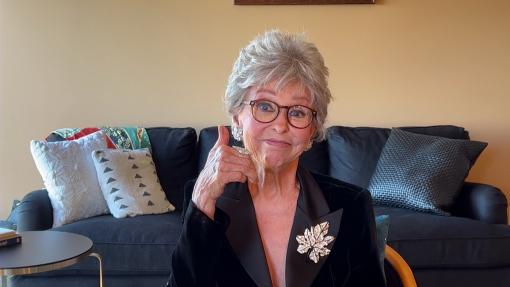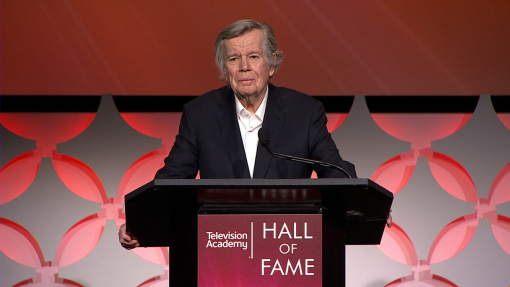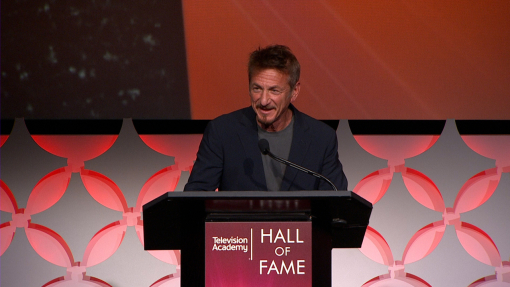If you've been wondering where to direct your complaint about your child or grandchild yelling "Yabba Dabba Doooooo!" all last summer, wonder no more. Blame William Hanna and Joseph Barbera. Right, Hanna-Barbera, the animation team. The Flintstones founding fathers.
What, you say, isn't that one person? Well, this is certainly the most often-asked question about Hanna and Barbera, one that has dogged the men since the late '50s, when Hanna-Barbera Productions was founded.
"They think my first name is Hanna," said Joe Barbera, “and that I'm a woman. And then a lot of people say, ‘Why is his name first?’ Well, we used to alternate on every cartoon, and I said, ‘To hell with this, let's toss a coin.’ And we tossed a coin, and that was it!”
You can distinguish Hanna from Barbera this way: Bill directs, Joe draws. That's the basic idea. Of course, they overlap in the idea department, and perhaps, in that way, the two are one. Together, they are two indispensable parts of one creative machine. After all, without a Hanna to complement a Barbera, or vice-versa, this world would never have been graced with the likes of such colorful (literally) personages as:
Tom and Jerry, Huckleberry Hound, The Flintstones, The Jetsons, Top Cat, Yogi Bear and BooBoo, Mr. Jinks and the "meeces" he hates "to pieces" (Pixie and Dixie), Scooby Doo, Magilla Gorilla, Wally Gator, Auggie Doggie and Doggy Daddy, Snagglepuss, Quick Draw McGraw, Hokey Wolf, Yackee Doodle, Inch-High.
Joe Barbera is 82 now. Bill Hanna is 84. The great animators are still making cartoons. (!) Although under present boss Ted Turner, who bought the Hanna-Barbera catalogue for his 24-hour cartoon channel, they are now developing projects independently. With a partnership that goes back 50 years, their resumes include working with many of the other cartoon legends: Tex Avery, Ub Iwerks, Paul Terry, Rudolph Ising, writers Michael Maltese and Warren Foster, voice master Mel Blanc, and so forth. With the recent passing of Walter Lantz, Hanna and Barbera are just about the last animation pioneers of the century who are still around. (To say nothing of remaining active in the business.)
"People say, How can you work together for 50 years and never fight?" said Barbera, who has just written his memoirs (My Life In 'Toons, a very charming read from Turner Books). "I said, We did fight, the very first week, and we haven't spoken since!"
In truth, their instant rapport practically singlehandedly (double-handedly?) bailed out of the fledgling, sputtering MGM cartoon department back in 1937.
"I came out in September of '37 [from the Paul Terrytoons Terry Studios in New York]," said Barbera, reached in his office at Hanna-Barbera Studios in Hollywood. "Bill was already there. The thing was a disaster. We were sitting in a room, and we could see the place crumbling around us. We decided to do our own cartoon."
Hanna, reached in his office at Hanna-Barbera, picks up the story: “I always liked Joe's drawings, and when the opportunity came, why, Joe and I worked together. We knew we needed two characters. We thought we needed conflict, and chase and action. And a cat after a mouse seemed like a good, basic thought.”
The very first cartoon they did, over and above the doubts of superiors at something so apparently hackneyed, was Puss Gets The Boot, starring Tom and Jerry. The "good, basic thought" won an Academy Award (the first of seven that the animators would eventually take home, along with eight Emmys).
"That was quite a coup," said Barbera. “MGM had been struggling to get a cartoon off the ground. They had hired Friz Freling, and he left. They'd hired Tex Avery, and he was unhappy. Finally it zeroed down to Bill and I making cartoons, and later Tex making cartoons, and it began to work.”
And work it did, for the next 20 years, until MGM discovered it was more cost-effective to recycle existing cartoons, and closed the flourishing operation in 1957. "That was our reward," Barbera said, still sounding a little incredulous. "And we were stunned. They cut off the best studio in the business." Bill and Joe grabbed a bunch of their MGM colleagues, and promptly opened Hanna-Barbera on Sunset Boulevard in Hollywood. By the early '60s, Hanna-Barbera 'toons like Huckleberry Hound and Yogi were household words. The Flintstones, don't forget, was prime time. They sold the studio in 1967.
"Of course,” said Barbera, "you can certainly say, and with great validity, 'What the hell did you sell it for?"'
Okay. What the hell did you sell it for?
"Well, at the time, about $12.6 million. You've got to imagine that a few years earlier, we were out of a job. So that seemed like a tremendous amount of money. I never looked back."
Taft Broadcasting ran H-B for 22 years (during which it produced the award-winning, highly popular Charlotte's Web in 1973 and Heidi's Song in 1982), sold out to Great America, and Great America sold out to Turner. Things are solid under Turner; Hanna and Barbera are developing features (Johnny Quest and a new Tom and Jerry) and new cartoons (Bill Hanna is working on a robot wolf character called Wind-Up Wolf and Hard Luck Duck, the weird tale of a duck living happily inside an alligator's head.)
But, to digress a little. …
Born in Melrose, New Mexico, July 14, 1910, Bill Hanna's first job is tied in with Hollywood history in a way that has nothing to do with animation:
"I was 20 years old, was working with the engineers on the Pantages Theater on Hollywood Boulevard," said Hanna, a genial man whose favorite companions are his coworkers. “I was sort of a flunky holding up that stick with the numbers on it, and they were setting floor elevations. I was the stick boy. That job lasted about four or five months, right in the middle of the Depression.”
He was essentially following in the engineering footsteps of his father (a longtime Santa Fe railroad man), when a friend suggested he come and work with him at a place called Pacific Title and Art. It was one of those lifedefining suggestions.
“I went there and got a job with a company called Harman-Ising Productions," he continued. “Hugh Harman and Rudolph Ising were animators who had started out with Walt Disney. They were making the very first Looney Toons and Merrie Melodies. I started doing a little bit of everything. I was washing the cels that had been used. We used to watch each sheet of celluloid, and then re-use them for every picture. … And I very soon found myself working at night with Rudy Ising, thinking up gags. Then, as time went on, I began writing little songs and lyrics for Hugh Harman.”
(It is appropriate at this juncture to note that Hanna is the musical half of the Hanna-Barbera team. That's right, he wrote The Flintstones song, and if pressed slightly, will delightedly break into "Yogi Bear is smarter than the average bear/Yogi Bear is always in the ranger's hair. …" )
"As time went on, I was able to do the direction, or timing of these cartoons," Hanna continued. “I would be working on the story so the animators could draw it. At that point, they were so slow in delivery that I got to do some pictures on my own. In 1937, I did a cartoon called To Spring (a minor classic today). It was a musical. I had written some music and lyrics for it, and I understand that one of the executives at MGM liked it very much. To make a long story short, when MGM started to put their own cartoon department together, they hired me as a director. That was in 1937.”
Shortly thereafter, Joe Barbera arrived.
But for a visit to Stillman's Gym in Brooklyn one morning, Joe Barbera, born in 1911 in New York's Little Italy, might have spent a career more in animosity than animation. That is, he was nearly a boxer.
"I won the lightweight boxing championship in high school,” he said. “A man asked to handle me as a manager. He managed then-current lightweight champ Al Singer. He says, ‘meet me up in Stillman's Gym,’ a very famous gym in New York where all the fighters train. There were five rings, and in each one people were banging their brains out. I found out that Al Singer had earned the munificent sum of $125,000 a year. And I thought, ‘oh my God!’ While I watched them train, my eye panned over slowly to the managers, in suits with gold chains and hats. Then I looked back in the ring, and I said, ‘Wait a minute, I'm in the wrong end of the business!’ And I turned around and went down the stairs and never went back.”
Barbera discovered his natural talent for drawing at age eight. It happened one rainy afternoon while he was lying on the floor looking at a book. On impulse, Bill decided to try and copy a picture of a puppy chasing a kitten. He duplicated it with little effort.
An art career did not come easily. His first serious job was in a bank ("which I hated, because I cannot add"), all the while drawing cartoons at night to "relieve my mental state." Lunch hours were spent running — literally — door to door, to draw attention to his drawings. Every day, Joe would tuck the latest batch under his arm, leave Wall Street, take the train to 42nd Street, and "run like crazy across Grand Central, up the stairs and out on to Park Avenue" to publications like Redbook, Collier's, Life, and deliver his latest work. He would pick up the rejects and leave new ones, week after week.
"And lo and behold, one day an envelope comes to my house in Brooklyn and my mother gives it to me," remembered Barbera, “and it says Collier's on it. I opened the thing and there's a check for 25 dollars. I was about 17, and I was making about 17 dollars a week. I remember pulling a make-believe faint on the floor of the kitchen, with my mother staring down at me, saying ‘What the hell's with this guy?’ So I went on to sell three more before the bank asked me to take a powder!”
The year, 1929, was not a good one to take a powder from one's job. Joe was laid off, along with the rest of the single people (married persons with families took priority). One day, while hanging around Greenwich Village, Joe ran into a friend who suggested he go across the street where a "guy from Disney" named Burt Gillette was starting a cartoon studio. "Tell him you're an animator," the friend said. "What the hell's an animator?" Barbera responded.
The short version of the story is that Barbera got the job on the strength of his published cartoons, learned animation by practicing "like hell" for six months, eventually moved to Paul Terry's Terrytoons, then was recruited by MGM. The rest is history — a history that lately has come back to haunt Hanna and Barbera in strange ways.
"I storyboarded all the Tom and Jerry's — every single one of them," said Barbera. “The other day I get a call from a guy in a gallery saying I have about 20 pages of one of your original storyboards, which I'd been looking for desperately. I said, ‘Really?’ It was called The Mermouse. He came over and showed them to me, and he didn't give them to me. He said, ‘I paid $1,500 for these. If you want it, give me the money and I'll let you have it.’ This is my own artwork! So I gave him the fifteen hundred bucks and I've got it in a drawer here.”
Aside from Tom and Jerry, you get the feeling that the project Hanna and Barbera are most proud of is The Flintstones, a project that almost never happened.
"We talked about making them as pilgrims, as Indians, as Italians," said Barbera, “and one of the fellows whose name was Dan Gordon made a sketch of one couple in the skins, like Fred and Wilma. As soon you saw them in these skins, everybody there said at once, ‘That's it.’ Everybody loved The Flintstones, but nobody bought it. They were afraid of it. On the very last day of an eight-day sales pitch, ABC bought the show. If ABC hadn't bought the show, I was ready to go back home, put the artwork in the closet, and that's it. No Flintstones.”
Added Hanna: "I really think that Fred Flintstone is my favorite character. I don't know, he yells a lot, and I yell a lot. We're alike in that respect."
Also in the respect of being a homebody, Hanna sticks pretty close to his Laguna Beach, California, home with his wife, Vi (they have two children and seven grandchildren), except for occasional getaways to a northern California ranch. Barbera and wife Sheila, parents of three, are just breaking in a new home in Studio City, a Los Angeles suburb — their longtime Sherman Oaks house having been irreversably damaged by the January earthquake. Barbera's time away from the studio is taken up with writing plays (he's had two optioned for Broadway) and "lying by the pool doing nothing."
How do the reigning elder statesmen of cartooning feel about being inducted into the Hall of Fame? "Well, I tell you," laughed onetime pugilist Barbera. "I said to myself, if I wait long enough, maybe they'll do it. So we waited. I think they kept saying 'Those two guys still around?’”
Hanna, interviewed on the very day of his 84th birthday in July (he cut the cake for a studio-wide celebration), offered this:
“Well, through the years. I've often read of people being inducted into that, and there were many very famous names that I recall. But I never once dreamed that somebody making little piddly cartoons would ever be inducted into anything like that!”
Or, as Fred Flintstone might have put it …
Well, you know.
This tribute originally appeared in the Television Academy Hall of Fame program celebrating William Hanna and Joseph Barbera's induction in 1994.

